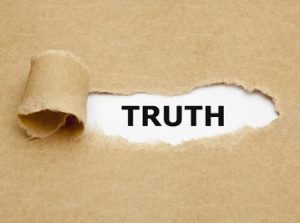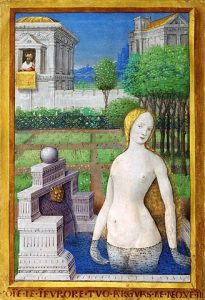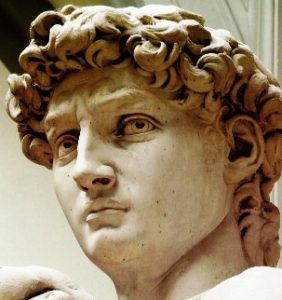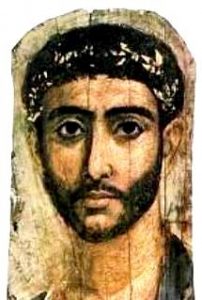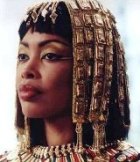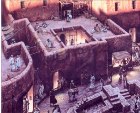 Bathsheba was a young aristocrat whose husband Uriah was from a distinguished military family.
Bathsheba was a young aristocrat whose husband Uriah was from a distinguished military family.
After she became pregnant to King David and he murdered her husband, she moved easily into the life of the royal harem.
Bathsheba’s Life in the Royal Harem
There is a lot of Hollywood nonsense about harems. Movies imply they were lurid dens of seduction and sex.
This is a male fantasy. It was not the reality.
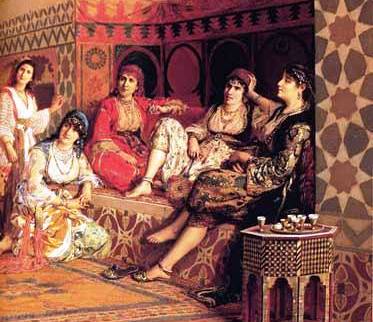
Power struggles in the harem were as common as in the larger world of men
The harem was a separate area for women and children in any house where there were a number of wives with children. The husband visited, but it was essentially the domain of women.
At the time that Bathsheba lived, women and their children usually occupied small individual rooms off a central courtyard.
- They were busy, devoted, and self-absorbed.
- They entertained, fed, reproduced and cared for themselves and their children.
- It was a self-contained world.
- There was constant movement, noise, activity.
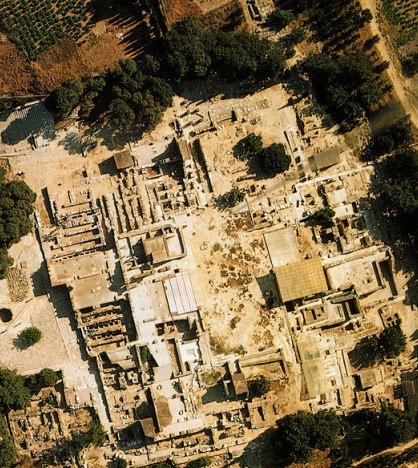
Aerial photograph of the palace of Knossos,
showing the layout of royal living quarters
Boys like little Solomon lived in the harem with their mother when they were small.
Girls lived there all their lives – though of course they moved from one harem to another when they married.
Right: aerial photograph of the palace of Knossos with the royal living quarters at right; David’s palace was smaller but probably had a similar plan
No woman was ever lonely, but at the same time there was fierce rivalry:
- for the attention of the husband who in this case was a king, and
- for preferment for each woman’s own children.
The future tribal or family leader was born in this harem, but the eldest son could not be sure of inheriting the leadership: a clever boy might be preferred to a less able older brother, or he might outwit his rivals as Solomon did.
Three kings: Saul, David and Solomon
The reigns of Saul, David and Solomon lasted from about 1020BC until about 922BC, ending with the death of Solomon. During this time Israel had a brief period of independence free from the foreign powers surrounding it.
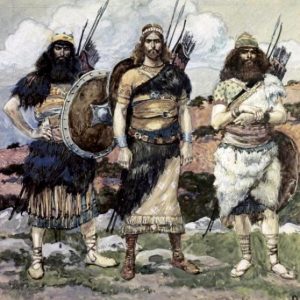 Saul was the first leader of this period. He fought to gain independence from the Philistines who had
Saul was the first leader of this period. He fought to gain independence from the Philistines who had
- superior technology,
- fortified positions and
- better organization,
all of which gave them the edge over the Hebrew tribal groups.
With the support of the prophet Samuel who gave him religious and psychological backing, Saul was at first victorious. However, he may have been mentally unstable and could not count on consistent loyalty from his followers – the young David, for one, undermined Saul’s authority.
So he was not able to gain a complete victory over the Philistines, and in a battle with them Saul was defeated and his favorite son Jonathan killed.
Saul committed suicide.
What was David like?
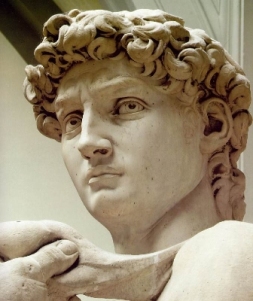
Statue of the young David, Michelangelo
David, waiting in the wings, took over as leader of the Israelite people. He was a subtle, brilliant and unscrupulous man: a military leader, poet, musician, schemer and diplomat. Much of his reign was spent in fighting to gain territory and incorporate newly acquired lands into the kingdom of Israel.
David used a combination of military power and diplomacy to lessen the threat of the Philistines and to take over Canaanite towns. At certain times in his reign he held the territories of Ammon, Moab, Edom, west of the Jordan, and Damascus.
He made treaties with regions he did not conquer.
Jerusalem becomes the capital
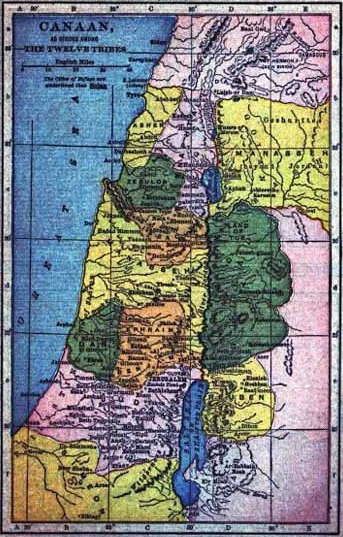
Map of Canaan/Israel,
as divided among the Twelve Tribes
The extension of territory demanded a control center and Jerusalem soon replaced Hebron as the capital of David’s kingdom. Here David established a religious, political and military center, so that Jerusalem became the unifying focus for the Israelites.
For maps of Judah and Jerusalem during David’s reign, see Bible Maps
Under Solomon, son of Bathsheba and David, Israel became an established kingdom, with
- a codified system of laws,
- a governing bureaucracy, and
- extensive foreign connections.
Trade was promoted, mineral wealth was exploited, and the army was enlarged and modernized.
What was the ‘wisdom of Solomon’?
The notion of the ‘wisdom of Solomon’ probably came from the heightened intellectualism at the court of Solomon: literature, historical chronicles and poetry flourished.
We should thank the court recorders for the stories from this period – but be aware of their bias as well. They were not fools. They didn’t write anything that might offend the people in power – or if they had to, they softened the story as much as possible.
How did things change under David?
The loose tribal confederation that had governed the Jewish people since the original settlement in Canaan (by Abraham and Sarah) was replaced by
- a centralized government located in Jerusalem
- a dynastic monarchy, kingship now passing from father to son – previously it had been by popular acclamation.
Women’s lives at that time
Before this, land ownership had been common at all economic levels. Almost all family groups had owned some land.
How did things change?
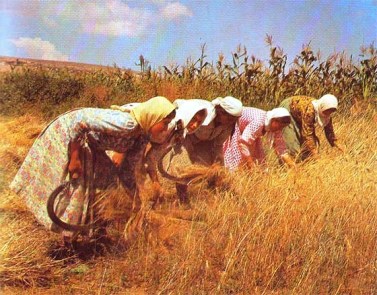
Group of peasant women harvesting a grain crop
Under David, and then increasingly under Solomon
- ownership was concentrated in the hands of the royal family, nobles and priests.
- peasant men and women were often dispossessed of the land their families had held for many generations.
- large estates, not smallholdings, became the norm
- tenant faming became more and more common
- day-laboring and short-term employment meant a loss of financial security
- slavery for debt became common.
The people most affected were those who were neither rich nor poor. This large group was made up of peasant farming families who occupied a status loosely equivalent to the lower middle-class in modern society.
Land was still the basis of wealth, and agriculture was still the mainstay of the economy, but ordinary people who produced the nation’s food were not as well off as they had been.
Their surplus output now supported a large, non-producing population, including the army, civil bureaucrats and the official priesthood.
It’s common enough, but that doesn’t make it any easier for the little people.
What did this mean for ordinary people?
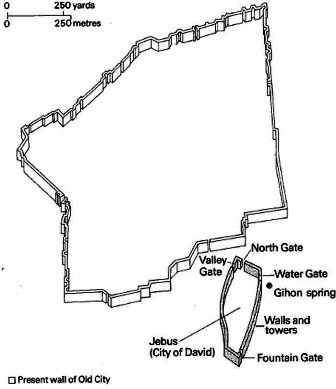
Jerusalem at the time of King David. The small area in the lower right of the map is Jebus, the fortress captured by David. The walled area above is a large flat rock on which the city of Jerusalem grew. The house of Uriah and the palace of David may have been in the upper area.
Jerusalem dominated the thinking and the government of Israel, and inevitably small villages became less important. So the focus of power moved away from the family unit, based in the village, towards the public, urban sphere.
This sphere was limited almost entirely to men. It included
- the army, which became larger and more organized, no longer a voluntary tribal militia
- the state bureaucracy which controlled tax, legislation and administration
- the religious bureaucracy, including the priesthood.
All of these were centered in Jerusalem and were limited to males. For the first time, women found themselves having very little say in the public life of the state.
For additional information on the lives of women in the Bible, see the links to
Family, Work and Religion: the tribe, the family, slaves, women’s tasks, beliefs
Milestones in a Woman’s Life: Puberty, menstruation, marriage, childbirth, death, burials
Search Box
![]()
Bathsheba links
Movies
Who succeeds the leader? The eldest, or the most competent?
© Copyright 2006
Elizabeth Fletcher

